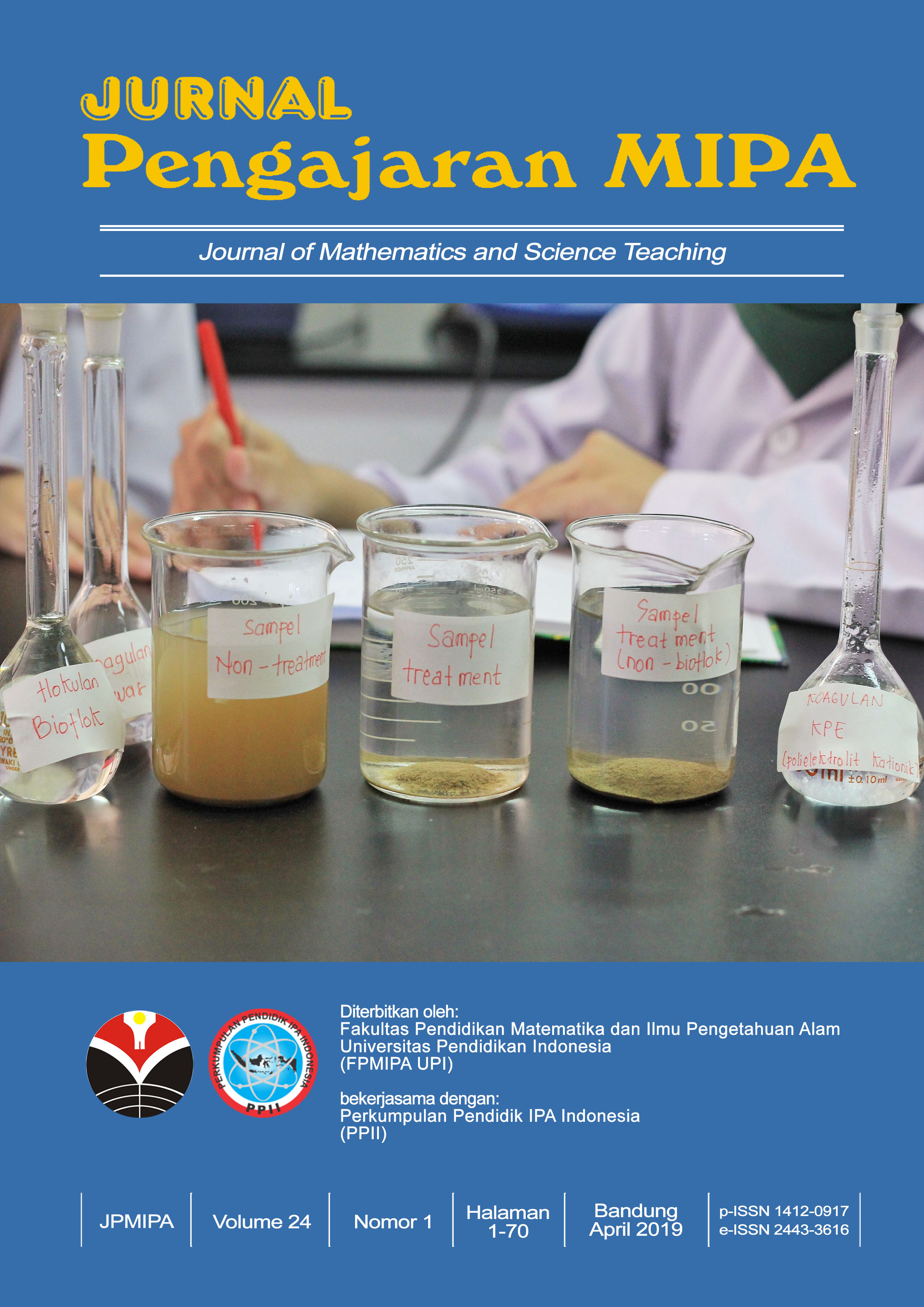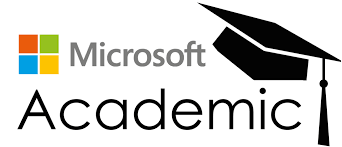INCREASING STUDENTS’ UNDERSTANDING OF EARTHQUAKES AND MITIGATION BY UTILIZING CHAVABOT AS LEARNING MEDIA
Abstract
Keywords
References
Alfiansyah, Muhamad Firdaus, Eka Pramono Adi, and Yerry Soepriyanto. 2022. “Pengembangan Multimedia Interaktif Ipa Dengan Fitur Feedback Untuk Siswa Kelas Viii.” JKTP: Jurnal Kajian Teknologi Pendidikan 5(1): 22–31.
Andika Isma et al. 2023. “Analisis Penggunaan Chatbot Berbasis AI Pada Model Hybrid Di Jurusan Teknik Informatika Dan Komputer.” Journal of Vocational, Informatics and Computer Education 1(2): 79–92.
Bunari, Bunari et al. 2024. “The Influence of Flipbook Learning Media, Learning Interest, and Learning Motivation on Learning Outcomes.” Journal of Education and Learning 18(2): 313–21.
Cahya, R. N., Suprapto, E., & Lusiana, R. (2020, February). Development of Mobile Learning Media Based Android to Suport Students Understanding. In Journal of Physics: Conference Series (Vol. 1464, No. 1, p. 012010). IOP Publishing.
Dexter, Franklin. 2013. “Wilcoxon-Mann-Whitney Test Used for Data That Are Not Normally Distributed.” Anesthesia and Analgesia 117(3): 537–38.
Dinta, Aprina, Amir Luthfi, and Molly Wahyuni. 2023. “Media Pembelajaran Matematika Berbasis Chatbot Untuk Kemampuan Pemahaman Konsep Pola Bilangan Siswa.” Journal of Education Research 4(4): 2385-2392.
Esti, I., Hersulastuti, H., Indiyah, P. A., & Kun, A. A. (2023). Portrait of education in Indonesia: Learning from PISA results 2015 to present. International Journal of Learning, Teaching and Educational Research, 22(1), 321-340.
Fenanlampir, Alberthus, John Rafafy Batlolona, and Imelda Imelda. 2019. “The Struggle of Indonesian Students in the Context of TIMSS and Pisa Has Not Ended.” International Journal of Civil Engineering and Technology 10(2): 393–406.
Fikri, Ely Khuzatul, Ai Nur Solihat, and Iis Aisyah. 2023. “Penggunaan Media Chatbot Dalam Model Pembelajaran Direct Instruction Sebagai Upaya Meningkatkan Hasil Belajar Siswa.” Global Education Journal 1(3): 335–51.
Gao, X., Li, P., Shen, J., & Sun, H. (2020). Reviewing assessment of student learning in interdisciplinary STEM education. International Journal of STEM Education, 7, 1-14.
Grassini, S. (2023). Shaping the future of education: Exploring the potential and consequences of AI and ChatGPT in educational settings. Education sciences, 13(7), 692.
Gunawardhana, P. D., & Palaniappan, S. (2016). Using multimedia as an education tool. 9th Annual International Conference on Computer Games Multimedia & Allied Technologies (CGAT 2016), 98–101.
https://doi.org/10.5176/2251-1679_CGAT16.15
Hamed, G., & Aljanazrah, A. (2020). The effectiveness if using virtual experiments on students’ learning in the general physics lab.
Irvani, A I, and R Warliani. 2022. “Development of Physics Demonstration Videos on Youtube (PDVY) as Physics Learning Media.” Jurnal Pendidikan Fisika Indonesia 18(1): 1–12.
Ismawati, Esti, Hersulastuti, Indiyah Prana Amertawengrum, and Kun Andyan Anindita. 2023. “Portrait of Education in Indonesia: Learning from PISA Results 2015 to Present.” International Journal of Learning, Teaching and Educational Research 22(1): 321–40.
Istiqomah, Khusnul, Vidya Setyaningrum, and Dwi Surya Atmaja. 2023. “Peredaran Darah Manusia Kelas V Development of Artificial Intelligence-Based Chatbot Teaching Materials on the Material of the Human Blood Circulatory System for Grade V.” Jurnal Persektif Pendidikan dan Keguruan 14(1): 50–56.
Karwasz, G. P., & Wyborska, K. (2023). How constructivist environment changes perception of learning: Physics is fun. Education Sciences, 13(2), 195.
Khatun, Nasrin. 2021. “Applications of Normality Test in Statistical Analysis.” Open Journal of Statistics 11(01): 113–22.
Krathwohl, David R. 2002. “Krathwohl, D.R. (2002). A Revision of Bloom's Tax n My: An v v w. Theory into Practice 41(4), 212-18.” Theory into Practice 41(4): 212–18.
Kus Eddy Sartono, E., Tunjung Sekarwangi, and Herwin Herwin. 2022. “Interactive Multimedia Based on Cultural Diversity to Improve the Understanding of Civic Concepts and Learning Motivation.” World Journal on Educational Technology: Current Issues 14(2): 356–68.
le Cessie, S., Goeman, J. J., & Dekkers, O. M. (2020). Who is afraid of non-normal data? Choosing between parametric and non-parametric tests. European journal of endocrinology, 182(2), E1-E3.
Mahya, Berlian Hariratul, and Deni Setiawan. 2024. “Development of Carabisatulus Chatbot Learning Media Based on Environment to Improve Science Learning Outcomes.” Jurnal Penelitian Pendidikan IPA 10(6): 3132–40.
Noviadhi, Iman Yunar et al. 2024. “Penerapan Teknologi Artificial Intelligence ChatBots Dalam Proses Belajar Mengajar Untuk Mata Kuliah Sistem Operasi Pada Program Studi Teknik Informatika Universitas Negeri Semarang Di Era Industri 4.0 Dan Society 5.0.” Mediasi 3(1): 93–105. http://jurnalilmiah.org/journal/index.php/mediasi.
Nurjanah, E, and R Ulfiyani. 2023. “AI-Based Chatbot Application as Learning Media on Writing Text Description Material.” International Conferences on Education 1(1): 1–10. https://jurnalfaktarbiyah.iainkediri.ac.id/index.php/proceedings/article/view/1767%0Ahttps://jurnalfaktarbiyah.iainkediri.ac.id/index.php/proceedings/article/download/1767/691.
Psycharis, Sarantos, Georgios Chalatzoglidis, and Michail Kalogiannakis. 2013. “Moodle as a Learning Environment in Promoting Conceptual Understanding for Secondary School Students.” Eurasia Journal of Mathematics, Science and Technology Education 9(1): 11–21.
Puspitasari, W., Noviyenty, L., & Anshori, S. (2024). The Effect Of Online English Vocabulary Game Toward Learning English Vocabulary (A Quasi-experimental quantitative study the Tenth Grade Students at SMAN 01 Semende Darat Laut in academic year 2023/2024) (Doctoral dissertation, Institut Agama Islam Negeri Curup).
Rabbany, I. N. Z. (2023). THE DEVELOPMENT OF ‘CHAVABOT’AS A LEARNING MEDIA THAT CAN FACILITATE STUDENTS CRITICAL THINKING IN EARTHQUAKES AND MITIGATION TOPIC (Doctoral dissertation, Universitas Pendidikan Indonesia).
Rachmavita, F. P. (2020, October). Interactive media-based video animation and student learning motivation in mathematics. In Journal of Physics: Conference Series (Vol. 1663, No. 1, p. 012040). IOP Publishing.
Rahim, F. R., Sari, S. Y., Sundari, P. D., Aulia, F., & Fauza, N. (2022, July). Interactive design of physics learning media: The role of teachers and students in a teaching innovation. In Journal of Physics: Conference Series (Vol. 2309, No. 1, p. 012075). IOP Publishing.
Rahmawati, Ana Silfiani, and Rahmawati P. Dewi. 2019. “Penggunaan Multimedia Interaktif (MMI) Sebagai Media Pembelajaran Dalam Meningkatkan Prestasi Belajar Fisika.” Jurnal Pendidikan Fisika dan Teknologi 5(1): 50–58.
Rosmiati, Nuri Seftiani, Atep Sujana, and Ani Nur Aeni. 2023. “Development of Chatbot Learning Media on Earth Rotation and Revolution Materials for Grade 6 Elementary School Students.” Jurnal IPA & Pembelajaran IPA 7(3): 210–33.
Roemintoyo, R., Miyono, N., Murniati, N. A. N., & Budiarto, M. K. (2022). Optimising the Utilisation of Computer-Based Technology through Interactive Multimedia for Entrepreneurship Learning. Cypriot Journal of Educational Sciences, 17(1), 105-119.
Rusli, Rusli. 2021. “Peranan Media Pembelajaran Dalam Proses Belajar Mengajar Pada Kelas VI SD Negeri 27 Buton.” Syattar 1(2): 123–30.
Safaruddin, I. N.S. Degeng, P. Setyosari, and N. Murtadho. 2020. “The Effect of PJBL with WBL Media and Cognitive Style on Students’ Understanding and Science-Integrated Concept Application.” Jurnal Pendidikan IPA Indonesia 9(3): 384–95.
Santyasa, I. W., Rapi, N. K., & Sara, I. (2020). Project based learning and academic procrastination of students in learning physics. International Journal of instruction, 13(1), 489-508.
Sedgwick, P. 2013. “Convenience Sampling.” Bmj 347(oct25 2): f6304–f6304. http://dx.doi.org/doi:10.1136/bmj.f6304.
Septiani, A. N. N. S. I., & Rejekiningsih, T. (2020). Development of Interactive Multimedia Learning Courseware to Strengthen Students' Character. European Journal of Educational Research, 9(3), 1267-1280.
Shingte, Kshitija et al. 2021. “Chatbot Development for Educational Institute.” SSRN Electronic Journal.
Sholihin, M., Sari, R. C., Yuniarti, N., & Ilyana, S. (2020). A new way of teaching business ethics: The evaluation of virtual reality-based learning media. The International Journal of Management Education, 18(3), 100428.
Suariqi Diantama. 2023. “Pemanfaatan Artificial Intelegent (AI) Dalam Dunia Pendidikan.” DEWANTECH Jurnal Teknologi Pendidikan 1(1): 8–14.
Suarsana, I. M., G. A. Mahayukti, I. K. Sudarma, and A. A.G.S. Pujawan. 2019. “The Effect of Interactive Mathematics Learning Media toward Mathematical Conceptual Understanding on Probability of Hearing-Impaired Students.” Journal of Physics: Conference Series 1165(1).
Suciani, Alia, Dadang Ruhiat, and Siti Dwi Rahayu Septiani. 2022. “Komparasi Hasil Analisis Beda Rata-Rata Menggunakan Metode Statistik Parametrik Dan Nonparametrik.” Jurnal Riset Matematika dan Sains Terapan 2(2): 76–91.
Sukmayadi, V., & Yahya, A. (2020). Indonesian education landscape and the 21st century challenges. Journal of Social Studies Education Research, 11(4), 219-234.
Wibowo, W., & Astriawati, N. (2020, April). The effectiveness of using Edmodo based e-learning in the applied mechanics course. In Journal of Physics: Conference Series (Vol. 1511, No. 1, p. 012121). IOP Publishing.
Wu, T. J., & Tai, Y. N. (2016). Effects of multimedia information technology integrated Multi-Sensory instruction on students’ learning motivation and outcome. Eurasia Journal of Mathematics, Science and Technology Education, 12(4), 1065–1074. https://doi.org/10.12973/eurasia.2016
DOI: https://doi.org/10.18269/jpmipa.v30i1.82810
Refbacks
- There are currently no refbacks.
Copyright (c) 2025 Universitas Pendidikan Indonesia (UPI)

This work is licensed under a Creative Commons Attribution-ShareAlike 4.0 International License.
JPMIPA http://ejournal.upi.edu/index.php/jpmipa/index is licensed under a Creative Commons Attribution-ShareAlike 4.0 International License
Jurnal Pengajaran Matematika dan Ilmu Pengetahuan Alam (JPMIPA) or Journal of Mathematics and Science Teaching
All rights reserverd. pISSN 1412-0917 eISSN 2443-3616
Copyright © Faculty of Mathematics and Science Education (FPMIPA) Universitas Pendidikan Indonesia (UPI)
View JPMIPA Stats









